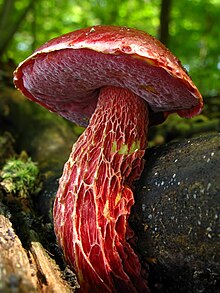Exsudoporus frostii
| Exsudoporus frostii | |
|---|---|

| |
| Scientific classification | |
| Domain: | Eukaryota |
| Kingdom: | Fungi |
| Division: | Basidiomycota |
| Class: | Agaricomycetes |
| Order: | Boletales |
| Family: | Boletaceae |
| Genus: | Exsudoporus |
| Species: | E. frostii
|
| Binomial name | |
| Exsudoporus frostii (J.L.Russell) Vizzini, Simonini & Gelardi (2014)
| |
| Synonyms[1] | |
| |
| Exsudoporus frostii | |
|---|---|
| Pores on hymenium | |
| Cap is convex or flat | |
mycorrhizal | |
| Edibility is edible | |
Exsudoporus frostii (formerly Boletus frostii), commonly known as Frost's bolete or the apple bolete, is a bolete fungus first described scientifically in 1874. A member of the family Boletaceae, the mushrooms produced by the fungus have tubes and pores instead of gills on the underside of their caps. Exsudoporus frostii is distributed in the eastern United States from Maine to Georgia, and in the southwest from Arizona extending south to Mexico and Costa Rica. A mycorrhizal species, its fruit bodies are typically found growing near hardwood trees, especially oak.
Exsudoporus frostii mushrooms can be recognized by their dark red sticky caps, the red pores, the network-like pattern of the
Taxonomy
The species was named by the
Due to lack of sufficient sequences, Wu and colleagues (2016) were reluctant to accept Exsudoporus and considered it a synonym of Butyriboletus, so they transferred E. frostii to the genus Butyriboletus and proposed a new combination Butyriboletus frostii.[13] However, following phylogenetic and morphological analyses clearly resolved Exsudoporus as a monophyletic, homogenous and independent genus that is sister to Butyriboletus.[14][15]
Exsudoporus frostii is commonly known as "Frost's bolete"[16] or the "apple bolete". In Mexico, its vernacular name is panza agria, which translates to "sour belly".[17]
Description
The shape of the cap of the young fruit body ranges from a half sphere to convex, later becoming broadly convex to flat or shallowly depressed, with a diameter of 5–15 cm (2.0–5.9 in).[18] The edge of the cap is curved inward, although as it ages it can uncurl and turn upward. In moist conditions, the cap surface is sticky as a result of its cuticle, which is made of gelatinized hyphae. If the fruit body has dried out after a rain, the cap is especially shiny,[4] sometimes appearing finely areolate (having a pattern of block-like areas similar to cracked, dried mud).[18] Young mushrooms have a whitish bloom on the cap surface.[19]

The color is bright red initially, but fades with age. The flesh is up to 2.5 cm (1.0 in) thick, and ranges in color from pallid to pale yellow to lemon yellow.[18] The flesh has a variable staining reaction in response to bruising, so some specimens may turn deep blue almost immediately, while others turn blue weakly and slowly.[4]
The tubes comprising the pore surface (the

The
Edibility and nutritional composition
This species is nonpoisonous.[21] Murrill wrote in 1910 of its edibility: "Usually viewed with suspicion because of its red hymenium, but its properties are not accurately known."[22] Since then, several authors have advised against consuming the species, due to its resemblance to other toxic red-capped boletes.[16][18][23] In his 100 Edible Mushrooms (2007), Michael Kuo notes that although the mushroom is apparently edible for some, it "affects others negatively".[24] David Arora mentions that it is commonly sold in rural markets in Mexico;[17] a 1997 study suggests that it is only consumed in rural areas in Querétaro state.[25] Its taste and odor have been described as "pleasant"[16] or "sweet"[21] and somewhat like citrus,[19] although the cuticle of the cap may taste acidic.[18]
Similar species

Other red-capped boletes include the poisonous
The fruit bodies of young specimens of
Ecology, habitat, and distribution

Exsudoporus frostii is a
The fruit bodies grow solitarily, scattered, or in groups on the ground under hardwood trees; the fungus fruits in summer to early autumn. William Murrill noted its preference for growing in "thin oak woods, where the light is sufficient to enable grass to grow",
Fruit bodies can be
See also
References
- ^ a b "Boletus frostii J.L. Russell". MycoBank. International Mycological Association. Retrieved 2011-06-21.
- ^ Frost CC. (1874). "Catalogue of Boleti of New England, with descriptions of new species". Bulletin of the Buffalo Society of Natural Sciences. 2: 100–5.
- ^ ISBN 0-472-85610-3.
- ^ JSTOR 2421647.
- JSTOR 4547605.
- JSTOR 3792925.
- ^ JSTOR 3753167.
- ISBN 978-0-85199-826-8.
- JSTOR 3755143.
- PMID 23931115.
- S2CID 15652037.
- ^ Vizzini A. (August 22, 2014). "Nomenclatural novelties" (PDF). Index Fungorum (183): 1.
- S2CID 22506275.
- S2CID 181958289.
- ^ PMID 35205856.
- ^ a b c Phillips R. "Boletus frostii". Rogers Plants. Archived from the original on 2012-02-18. Retrieved 2012-03-01.
- ^ ISBN 0-89815-169-4.
- ^ ISBN 0-472-85590-5.
- ^ ISBN 978-0-8156-0588-1.
- ^ Kuo M. (January 2007). "Boletus frostii". MushroomExpert.Com. Retrieved 2012-03-01.
- ^ ISBN 978-0-7627-3109-1.
- JSTOR 3753292.
- ISBN 0-8156-2666-5.
- ^ ISBN 978-0-472-03126-9.
- ^ .
- ISSN 0082-0598.
- ^ a b Alessio CL. (1981). "Boletus siculus inzenga il gia presunto B. frostii Russell rinvenuto in Italia" [Boletus siculus is the supposed Boletus frostii discovered in Italy]. Micologia Italiana (in Italian). 10 (2): 40–2.
- S2CID 83544311.
- ^ Ortiz-Santana B, Lodge DJ, Baroni TJ, Both EE (2007). "Boletes from Belize and the Dominican Republic" (PDF). Fungal Diversity. 27 (2): 247–416 (see p. 322).
- ^ JSTOR 3756310.
- ISBN 1-4051-3066-0.
- PMID 19508503.
- ^ Halling RE, Muller GM. "Boletus frostii". Macrofungi of Costa Rica. New York Botanical Garden. Retrieved 2011-09-29.
- ISSN 0390-0460.
- JSTOR 3761625. Archived from the originalon 2015-09-23. Retrieved 2011-06-21.
- S2CID 40865857.
External links
- Mushroom Observer Photographs
